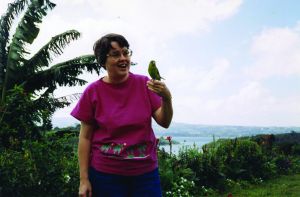Still my father’s SST
We celebrate 40 years of Goshen’s Study-Service Term (SST) this year, but SST began influencing me even earlier, when it was still just a gleam in the eyes of the Committee on the Future of the College. In the fall of 1966, then-President Mininger and my father, Henry D. Weaver, traveled to a number of Central American countries, visiting possible locations for the proposed program. Every day Dad bought a colorful postcard, scribbled a nearly indecipherable message and sent it to one of his children. And in each country he bought a small doll dressed in local garb for us. The message was clear – SST meant travel to fascinating foreign places. I was hooked.

Over the years, I’ve had the opportunity to experience SST from a variety of angles: as a faculty leader’s child (Poland, 1975), as an SSTer myself (Costa Rica, 1977), as a co-leader with my husband, John (Costa Rica, 1992-93), and as a parent (David in Ethiopia, 2005; Beth in China, 2008). Locations and technology have changed, but SST is still SST, and it is much more than the tourism that intrigued me as a child.
True, travel to foreign destinations is usually part of the package. This fall we sent our daughter Beth off to China with hugs, tears and the traditional prayer circle at the south portico of the Union. As the charter bus lumbered away, several parents grudgingly decided that the scheduled ride to O’Hare, three plane flights and 30 hours of travel were roughly equivalent to our own SST memories of 24-hour bus or van trips to Miami and a flight to a host country.
But SST is about much more than travel adventure. At its heart is intimate interaction with another culture, learning its language and its history, and connecting with its people. The amount of connection varies due to circumstances, of course. This fall, for the first time the Chinese SSTers were able to stay with host families instead of in a dorm. Beth felt warmly welcomed by both her families, and well fed, experiencing that refrain familiar to me from my experiences in Poland and Costa Rica: “Here, have some more of this – you aren’t eating enough!”
With the connections SSTers now have with home via e-mail, Facebook and Skype, some may be tempted to exclaim, “This is not your father’s SST!” There have been changes over the years, to be sure, but the key elements of the original proposal are still there: an international term that provides contact with another, very different culture, in a group led by a GC professor, with a period of study and a period of service. And that contact, whatever facet of SST we have experienced, has touched and changed many lives. I’m still hooked.
By Sally Weaver Glick ’79




